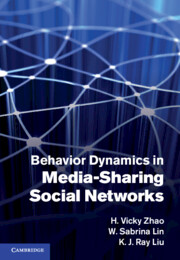Book contents
- Frontmatter
- Contents
- Preface
- Part I Introduction
- 1 Introduction to media-sharing social networks
- 2 Overview of multimedia fingerprinting
- 3 Overview of mesh-pull peer-to-peer video streaming
- 4 Game theory for social networks
- Part II Behavior forensics in media-sharing social networks
- Part III Fairness and cooperation stimulation
- Part IV Misbehaving user identification
- Part V Media-sharing social network structures
- References
- Index
1 - Introduction to media-sharing social networks
from Part I - Introduction
Published online by Cambridge University Press: 28 April 2011
- Frontmatter
- Contents
- Preface
- Part I Introduction
- 1 Introduction to media-sharing social networks
- 2 Overview of multimedia fingerprinting
- 3 Overview of mesh-pull peer-to-peer video streaming
- 4 Game theory for social networks
- Part II Behavior forensics in media-sharing social networks
- Part III Fairness and cooperation stimulation
- Part IV Misbehaving user identification
- Part V Media-sharing social network structures
- References
- Index
Summary
With recent advances in communications, networking, and computer technologies, we have witnessed the emergence of large-scale user-centered web 2.0 applications that facilitate interactive information sharing and user collaboration via Internet – for example, blogs; wikis; media-sharing websites such as Napster, Flickr, and YouTube; social networking services such as Facebook, LinkedIn, and Twitter; and many others. Different from traditional web applications that allow only passive information viewing, these web 2.0 sites offer a platform for users to actively participate in and contribute to the content/service provided. The resulting trend toward social learning and networking creates a technological revolution for industries, and brings new experience to users.
The emergence of these websites has significant social impact and has profoundly changed our daily life. Increasingly, people use the Internet as a social medium to interact with one another and expand their social circles, to share information and experiences, and to organize communities and activities. For example, YouTube is a popular video-sharing website on which users upload, share, and view a wide variety of user-generated video content. It targets ordinary people who have Internet access but who may not have a technical background on computers and networking, and enables them to upload short video clips that are viewable to the worldwide audience within a few minutes. Its simplicity of use and the large variety of content offered on the website attract more than one billion views per day, according to a blog by Chad Hurley (cofounder of YouTube) on October 9, 2009, and make video sharing an important part of the new Internet culture.
- Type
- Chapter
- Information
- Behavior Dynamics in Media-Sharing Social Networks , pp. 3 - 13Publisher: Cambridge University PressPrint publication year: 2011



